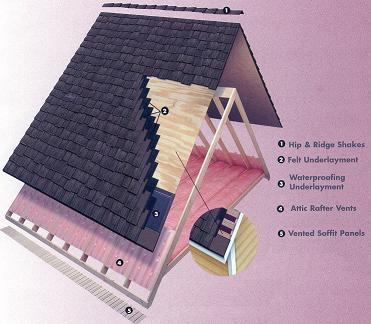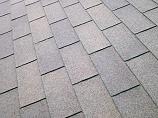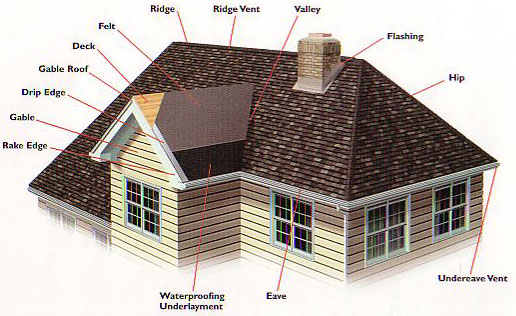Murph's Roofing Q & A

How do I know if I need a new roof?
Missing, cracked or curling shingles, Stains on interior walls or ceilings,Leakage in the attic after heavy rains, Blistering or peeling paint,excessive surface granules accumulating in the gutters or downspouts. Shingle,sheathing or siding decay, High energy bills to name a few.
Can my roof be repaired or must it be replaced?
It's usually best to have an experienced roofer inspect your roof when deciding whether to repair or replace your roof. You also need to take into consideration the age of the roof. re your “20 year” shingles more than 15 years old or were they installed just a few years ago. If the roof is well within it's lifespan and you aren't seeing other warning signs chances are good you can simply repair and/or replace those shingles that are causing a problem.
How long does it take to replace a roof?
Replacing a roof, whether on a commercial or residential building, is a labor-intensive project and, depending on the type of roof, could take anywhere from a few days to 2 or more weeks. The time involved is substantially affected by the weather, as well. Wind, snow, rain, or even just the threat of one of these and may slow the process considerably.
If my roof leaks, will I need to have it totally replaced?
In limited cases, no. Leaking can occur because some flashing's have come loose or because a section of the roof has been damaged. A roof failure, on the other hand, is generally irreversible and occurs from a large portion being damage by a severe storm, hurricane, tornado or high winds, choice of materials, or from the installation of a roof system inappropriate for the home or building.
What are my options if I decide to reroof?
You have two basic options: You can choose a complete replacement of the roof system, involving a tear-off of your existing roof system, or re-cover the existing roof system, involving only the installation of a new roof system. f you've already had one re-cover installed on your original roof system, check with a professional roofing contractor. In many instances, building code requirements allow no more than one roof system re-cover before a complete replacement is necessary.
How long can I expect my roof system to last?
Most new roof systems are designed to provide useful service for about 20 years. Some roof system types, such as slate, clay tile and certain metal (e.g., copper) systems, can last longer. Actual roof system life span is determined by a number of factors, including local climatic and environmental conditions, proper building and roof system design, material quality and suitability, proper application and adequate roof maintenance. Roofing product manufacturers offer a variety of warranties on their products. Take a close look at those warranties to see what responsibilities and financial obligations manufacturers will assume if their products fail to reach their expected lives.
What are the types of roofing?

Asphalt shingles: most homes in North America with steeply sloped roofs are covered in asphalt shingles. Asphalt shingles are durable and extremely affordable. They are produced in several colours and styles, and with such a wide selection, homeowners will no doubt find asphalt shingles suitable for their home. All asphalt shingles are produced in generally the same way. A coating of colored mineral granules made of crushed rock coated in ceramic is applied to a mat made from either wood, cellulose or fiberglass combined with waterproof asphalt. Over time, the shingles will shed some of these granules, collecting in gutters and at the bottom of downspouts. When doing a routine cleaning of the gutters and downspouts, checking the amount of these shed granules can give you valuable insight into their condition. A drawback to asphalt shingles is that their lifespan is normally about twenty years. Damage can result from harsh environmental factors or poor installation, so they require routine check ups to monitor their condition. If any wear or tear appears, repair should be done immediately to the damaged shingle(s) to prevent serious damage. Serious damage includes water leakage affecting the supporting structure, which could be irreparable.
Metal Lightweight and resistant to fire, metal roofs can be made from aluminum, galvanized steel, copper, zinc, stainless steel, and titanium (the most expensive). Metal is more expensive than asphalt shingles, but are longer lasting and require less maintenance. If installed properly, the only threat to a metal roof is rust. However, rust can be controlled with the application of protective paint, rather than replacing the whole roof. Metal roofs are ideal for warmer climates, such as the southern United States. As metal reflects heat, cooling costs will be reduced dramatically with proper insulation. Metal gutters and downspouts attached to a metal roof can be more aesthetically pleasing, as there is continuity in their appearance. However, it is necessary that sealant is applied at the gutters to keep it waterproof.
Tile Roofs A tile roof is a beautiful addition to your home that is durable and long lasting. They can be manufactured from concrete, slate or clay and come in a variety of shapes, weights, and sizes. Some may be specially treated to keep them from changing colour as they age. A major drawback to tile roofs is that because it is made out of a naturally dense material, the total weight of the roof can be quite heavy. As a result, some structures may not be able to support this weight. Installation requires skilled labour, and though routine checkups are done less frequently than other types of roofs, it is recommended that professionals are hired for the task as they are expensive to maintain or replace. This advice may also extend to other aspects of roof maintenance, such as gutter cleaning and painting. Hiring a professional who knows how to work on or around a tile roof can reduce or prevent any damage that may result from those less experienced.
How can I estimate how much roofing I'll need?
Knowing how much roofing material you'll need will make it easier to compare bids from contractors. Roofs are measured in 100-square-foot areas, or squares. A square of three-tab shingles is typically three bundles, while for laminated shingles a square is usually four bundles. To gauge your needs, multiply the overall length and width of each section of your roof to determine the square footage, adding 10 percent to allow for waste. Then divide that number by 100 to determine how many squares the job will require. If you don’t want to go on your roof to get accurate measurements, you can estimate the roof surface area by using the length and width of your home as the basis. Increase each of these dimensions by the amount the roof overhangs the exterior walls on each side of the home. Since the roof might have distinct sections and because most roofs are pitched, you'll want to increase the number you calculate. Adjust the calculated area by about 5 percent for a low-sloped simple roof to about 40 percent for a complex roof design with a steep slope. When you get bids, be sure the contractor includes the cost of the underlayment (roofing felt), which creates a moisture barrier for the wood sheathing and rafters underneath. And don't forget to factor in adding an ice-and-water shield, which runs along the eaves and the valleys where two wings of the roof intersect, as well as new drip edges and metal flashing, which are often needed around pipes, chimneys, and the like.

Can I do the work myself?
Most work should not be done yourself. Professional roofing contractors are trained to safely and efficiently repair or replace roof systems. You can damage your roof system by using improper roofing techniques and severely injure yourself by falling off or through the roof. Maintenance performed by home and building owners should be confined to inspecting roof systems during the fall and spring to check for cracked or curling shingles and cleaning gutters filled with dead leaves and other debris. If you must inspect your roof system yourself, use a firmly braced or tied-off ladder equipped with rubber safety feet. Wear rubber-soled shoes and stay on the ladder (and off the roof system), if possible.
What will a new roof cost?
The price of a new roof system varies widely, depending on such things as the materials selected, contractor doing the work, home or building, location of the home or building, local labor rates and time of year. To get a good idea of price for your roof system, get three or four proposals from reputable contractors in your area. Keep in mind that price is only one factor, and it must be balanced with the quality of the materials and workmanship. For each roofing material, there are different grades and corresponding prices. There also are a variety of styles and shapes. You need to look at the full product range and make a choice based on your budget and needs. Within the roofing profession, there are different levels of expertise and craftsmanship. Insist on a contractor who is committed to quality work.
Why Choose Murph's Roofing & Repair Co. for Your New Roof or Roof Repair?
- Every roof built with quality, integrity, and service
- Qualified for residential roofing and commercial roofing projects
- Affordable roofing prices and competitive estimates
- Quality workmanship on new roofs, roof replacement, and roof repairs
- One of the most professional and reliable roofing contractors in Rhode Island
- Strong materials warranties and a 5 year warranty on labor and workmanship
In addition, we have residential roofing expertise with asphalt, metal, slate and wood shingle roofs and flat roofs.
- New roofs
- Roof replacement
- Roof repairs
- Waterproofing leaky roofs
- Roof inspections for real estate transactions and preventive roof maintenance
- Installation, replacement or repairs of gutters
- Flat roof solutions for your low slope roof including sun rooms, garages, and porches
If, after inspecting your roof, it is determined that you need any repair work, this is what you can expect from us:
1. Surface Preperation/Demolition
- All necessary permits are obtained.
- A dumpster, if space available, is brought in and removed upon completion.
- All existing shingles, tar paper and flashings are fully removed.
- All sheathing and roof penetration flashings are inspected and loose sheathing is re-nailed securely at no additional charge.
- Rotted Sheathing, if seen, is repaired or replace per customer consent.
2. Installing Your New Roof
- 15 to 30lb. felt under layment (tar paper) is laid down as a protective layer over the sheathing.
- It is vital to install new aluminum flashing around roof edges. This is another step that is skipped by many contractors to keep their cost low, at the price of possibly rotting the fascia boards and causing peeling paint due to water run-off. We typically use an 8" aluminum drip edge, where our competitors use a 5" (which provides less protection from water).
- Install new pipe vent boots and ridge vent. A ridge vent can be cut for you if you do not currently have one--this allows the house to breathe and lengthens the life of the roof through increased circulation. The ventilation provided by a ridge vent also helps to prevent mildew build-up in the attic and is often needed to bring the roof in compliance with recent building codes.
- Additional ventilation will be installed to help the roof perform optimally, if measured to be needed by the project consultant during the original estimate and chosen by the customer.
3. Clean Up is NOT an Afterthought
- Leaving your home in BETTER shape than the way in which we found it is our goal.
- Clean up is performed daily and at the completion of the job.
- All supplies and refuse are promptly taken away.
- Plant beds are cleaned and old tar paper, nails and rotted sheathing are removed
- An inspection is performed by our foreman or project leader.
4. Warranty
- Beyond the manufacturer's product warranty, Murph's Roofing & Repair offers a standard 5yr. warranty on all work performed on your roof.
- This means we will perform any covered repairs at no labor cost to you, the original purchaser.
Roofing Terms and Explanations
- Asphalt - an organic bituminous compound used in the manufacturing of composition shingles.
- Asphalt Roofing Cement - used to bond roofing materials, also known as flashing cement or mastic
- ASTM - American Society for testing of Materials. A voluntary organization concerned with the development of standards, testing procedures, and specifications. Many city building codes use ASTM standards.
- Base Flashing - the portion of the flashing which is attached to, or rest on the roof deck.
- Blend- mixtures of various colored granules on the surface of shingles.
- Blind Nailing - nails driven in such a way that the heads are concealed by succeeding layers of roofing materials.
- Blisters - bubbles that may appear on the surface of asphalt roofing.
- Bridging - a method of reroofing where the new shingles follow the contour of the old roofing. Also called "butting up". It is almost always desirable to tear off old roofing.
- Built-Up Roofing - a flat or low sloped roof made up of layers of asphalt and ply sheets. (AKA BUR)
- Butt - the portion of the shingle exposed to the weather, sometimes called the "tab" of the shingle.
- Cant Strip - a 45 degree beveled wood, fiberboard, or metal strips at the junction of the roof and a vertical surface used to break a right angle. Primarily used in low sloped roofing.
- Cap Flashing - flashing on a vertical surface to prevent the flow of water from getting behind the base flashing. The cap flashing overlaps the base flashing. This flashing (AKA counter flashing) is generally not changed in a reroofing job.
- Caulk - a substance used to fill a joint or void.
- Cement - a substance, when cured, binds to surfaces together.
- Class "A" - the highest fire resistance rating for roofing as per ASTM E-108. Shingle with this rating should withstand severe exposure to fire from sources originating outside the building. Other classed are B and C.
- Closed Valley - when roofing materials cover the entire valley. Unless otherwise requested, Bert Roofing Inc. primarily installs closed valleys.
- Coating - a layer of viscous asphalt applied to shingles in which granules are embedded.
- Collars - pre-formed flange placed over a vent pipe. (AKA vent sleeve) There are two types, lead jacks and rubber boots.
- Counter Flashing - see Cap Flashing.
- Course - a horizontal unit of roofing running the length of the roof.
- Cricket - a small peaked saddle constructed on the top of the basic roof and behind the chimney. A cricket is generally not required.
- Cupola - a structure rising above the main roof. It is usually ornamental, but may be used for ventilation.
- Dead Level - a roof or section of roof without any pitch.
- Deck - the material installed over the framing of a structure on which shingles are installed. The primary materials are Oriented Strand Board (OSB) and cdx Plywood.
- Double Coverage - a method of applying roof shingles so that two complete layers of material are provided.
- Dormer - a window unit projecting through the sloping plane of the roof.
- Drip Edge - usually metal strip used on eves and rakes to allow for water run off without damaging underlying materials
- Drip Course - the first course of shingles that slightly overhangs the edge.
- Eave - the horizontal edge of a roof that projects over the outside wall.
- Exposure - the portion of the shingle that is exposed to the weather. usually measured from the butt of one shingle to the butt of the next overlapping shingles.
- Lap - the overlap of surface of one roofing material to another.
- Laminated Shingles - shingles containing more than one layer of tabs creating extra thickness. (AKA dimensional or architectural)
- Lock Shingles - a shingles with a mechanical locking feature. These are not common.
- Low Slope Application - method of applying shingles on slopes between 2 and four inches per foot.
- Mansard Roof - a vertical portion of roofing.
- Mastic - see asphalt roof cement.
- Nesting - see bridging
- Normal Slope Application - method of installing shingles between 4 and 21 inches per foot.
- Open Valley - valley in which metal is used and roofing material does not cover entire valley area as in a Closed Valley.
- Saturant - asphalt used to impregnate felt for waterproofing and strength.
- Seal Down - a factory applied asphalt strip used to bond a shingle to the one above. This is used to provide wind resistance.
- Sheathing - exterior grade boards used as a roof deck.
- Side Lap - a horizontal lap
- Skirt Flashing - A large often single piece of flashing commonly found at the bottom of a dormer or addition.
- Slope - the degree of incline of a roof plane.
- Soffit - the finished underside of an eave.
- Soffit Vent - An under eve opening needed for intake of outside air. These are not part of a typical roofing job, but are needed for good attic ventilation.
- Soil Stack - a vent pipe that penetrates the roof.
- Span - the horizontal measurement from eave to eave.
- Spire - a tower of roof tapering up to a point.
- Square - a unit of roof measurement covering 100 square feet.
- Square Butt Shingles - generally three tab 20 year shingles - not laminated.
- Starter Course - the first course of shingles installed on your roof. It will be under the first exposed row. Often these shingles are 20 year three tab shingles. So as to not create an awkward hump, these are used even when heavier laminated shingles are installed.
- Step Flashing - flashing along a roof slope against a wall or chimney using succeeding courses of flashing material placed in conjunction with layers or courses of roofing materials. Step Flashing is generally in 4 by 4 by 8 inch pieces.
- Tab - portion of strip shingles defined by cut outs or slots so when installed, material appears to be individually applied.
- Underlayment - an asphalt saturated felt applied over the roof deck and under the roofing material.
- Valley - the intersection of two roof slopes.
- Vent - an outlet for air
- Weathering - changes in color, texture or efficiency brought about by exposure to outside elements
ARTICLES ON ROOFING
When it comes to home improvement, it doesn't always pay to take the cheaper option. In fact sometimes it's a losing venture when you find yourself making expensive repairs or replacements down the road because the cheaper option didn't hold up. And sometimes you'll find that you can save more in the long run by spending more up front. This is certainly the case when it comes to choosing metal roofing versus asphalt shingles for your home. While metal roofing costs more money to purchase and install compared to asphalt shingles, you can save a significant amount over the long life of the roof.
What Makes Asphalt Shingles So Inexpensive?
There is a reason why asphalt shingle roofs are a cheaper roofing option compared to metal roofs, they are simply an inferior product. Here are some of the ways that asphalt shingles under-perform vs metal roofing : 1. Material - asphalt shingles are susceptible to corrosion and algae growth and are capable of tearing and flying away during heavy winds and rain. Plus, they can weigh five times more than metal panels per square, putting more strain on the foundation and structure of your home. 2. Warranty - asphalt shingle warranties are generally limited and in some cases don't even cover necessary repair or replacement 3. Energy Efficiency - asphalt shingles absorb heat from the sun, transferring that heat directly into your home during the hot summer months, forcing your cooling unit to work on overdrive, and sending your home energy bills sky high. 4. Environmental Impact - asphalt shingles contribute a significant amount of landfill waste every year since they have a shorter life span and need to be replaced more often. And because of their tendency to absorb heat, they contribute to the urban heat island effect, pollution, smog, and overall energy consumption.
Is Metal Roofing Worth the Investment?
Metal Roofing is a superior roofing product compared to asphalt shingles and is worth its value in terms of protection for your home, long life expectancy of the roof, a transferable Limited Lifetime Warranty, and pure aesthetic curb appeal. Here are some of the ways that metal roofing out-performs asphalt shingles: 1. Warranty - some metal roofing comes with limited Lifetime Warranties that last as long as you live in your home and help protect your investment. 2. Energy Efficiency - metal roofing reflects more of the sun's heat energy, preventing excess heat from transferring into the attic and helping to lower homeenergy consumption. 3. Environmental Impact - metal roofing is one of the most recycled materials on earth, saving waste from entering our landfills and recyclable after its long life span. And because of its tendency to reflect the sun's rays, it helps to prevent smog and the urban heat island effect, and ultimately reduce the need for burning fossil fuels by saving on energy consumption.
Roof Insulation Makes Your Home More Comfortable
If you are considering taking the plunge and having your home insulated, you may want to consider roof insulation. Just what is roof insulation? It is a product that lives up to its name, and could be called the hidden insulation, because many people do not even know that the outside form of it exists.
They do research about the best kind of insulation for their home, and make a choice without becoming informed about roof insulation.Roof insulation works silently to make your living space more comfortable. It has been tested and found to reduce the overall cost of heating your house by an astonishing 13%!
This type of insulation can also help to keep your house a great deal cooler during the summer months. That can add up to a nice amount of money in a few years time, perhaps even enough to pay for your roof insulation and installation! There are two types of roof insulation. One of these types goes on the outside of your home in the area between the roof’s shingles or tiles, and the sheathing used on top of the rafters as a place for the roofing. Normally, a type of foam board is stapled to the sheathing, and the roofing material is then installed on top of the foam board. This gives you a layer of protection from hot and cold air drifting into your home’s attic and then into your living space.
Rigid fibreglass insulation can also be used for this purpose. It is a lot easier to install this type of insulation when you are also replacing your roof shingles or tiles, but it can definitely be used on a roof that is already in place or a flat roof as well.
It may only be necessary to place roof insulation in your attic space, which some contractors will call loft insulation. This is the more common type of roof insulation, and you will find that more people have heard of this alternative.
Rafter vents are needed to keep any build up of moisture from getting the insulation wet. Once this has been accomplished, the space between the rafters can then be filled with insulation. Spray foam insulation is one choice that the homeowner has for roof insulation in their attic space. A smaller attic, such as one you cannot stand up in, is a good candidate for this type of insulation. Professionals spray the foam into all the spaces, cracks, and crevices, and it does an excellent job of keeping out air.
Another type of attic roof insulation is that familiar pink coloured roll that looks a bit like a huge roll of carpet. These are known as batts, and are usually made of fibreglass, but can also be made from rock wool. The pink batts are flexible, and it is easy to cut and fit them into the needed spaces.
It is best to leave this type of installation to a professional, for fibreglass can be rather tricky to work with. It is easy to get some of the fibres embedded into your ski, or even in your eyes. As you might imagine, this is quite painful, and potentially dangerous to your eyesight. There is also the risk of breathing in the glass fibres.The various types of roof insulation that are available will make your home a comfortable place to live, whether it is winter or summer.



